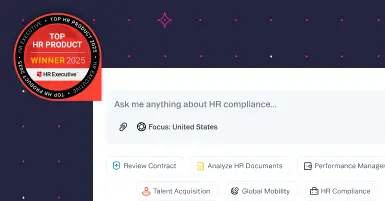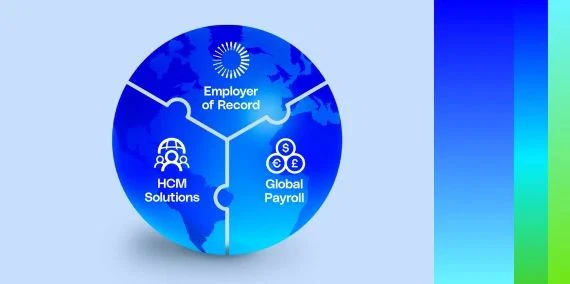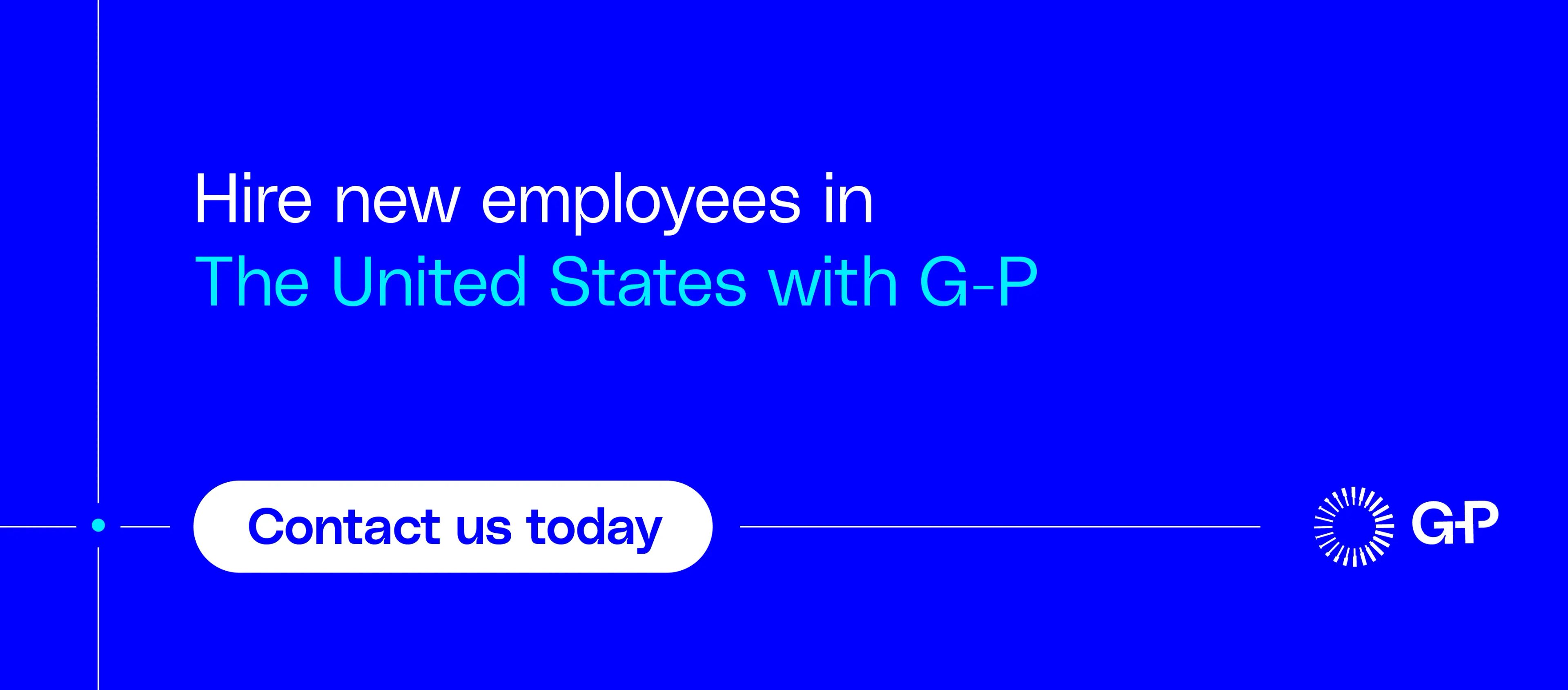The U.S. is the world's largest economy by nominal GDP (approximately USD 30.5T) in 2025. The U.S. also represents the largest consumer market in the world. It continues to be a global leader in technology, finance, and innovation (Silicon Valley and Wall Street), offering access to venture capital and a high-income customer base.
Before expanding into the U.S., you’ll need to understand contracts, taxes, wages, benefits, and other employment laws. Our guide will tell you everything you need to know about hiring in the U.S.
What to know before hiring in the U.S.
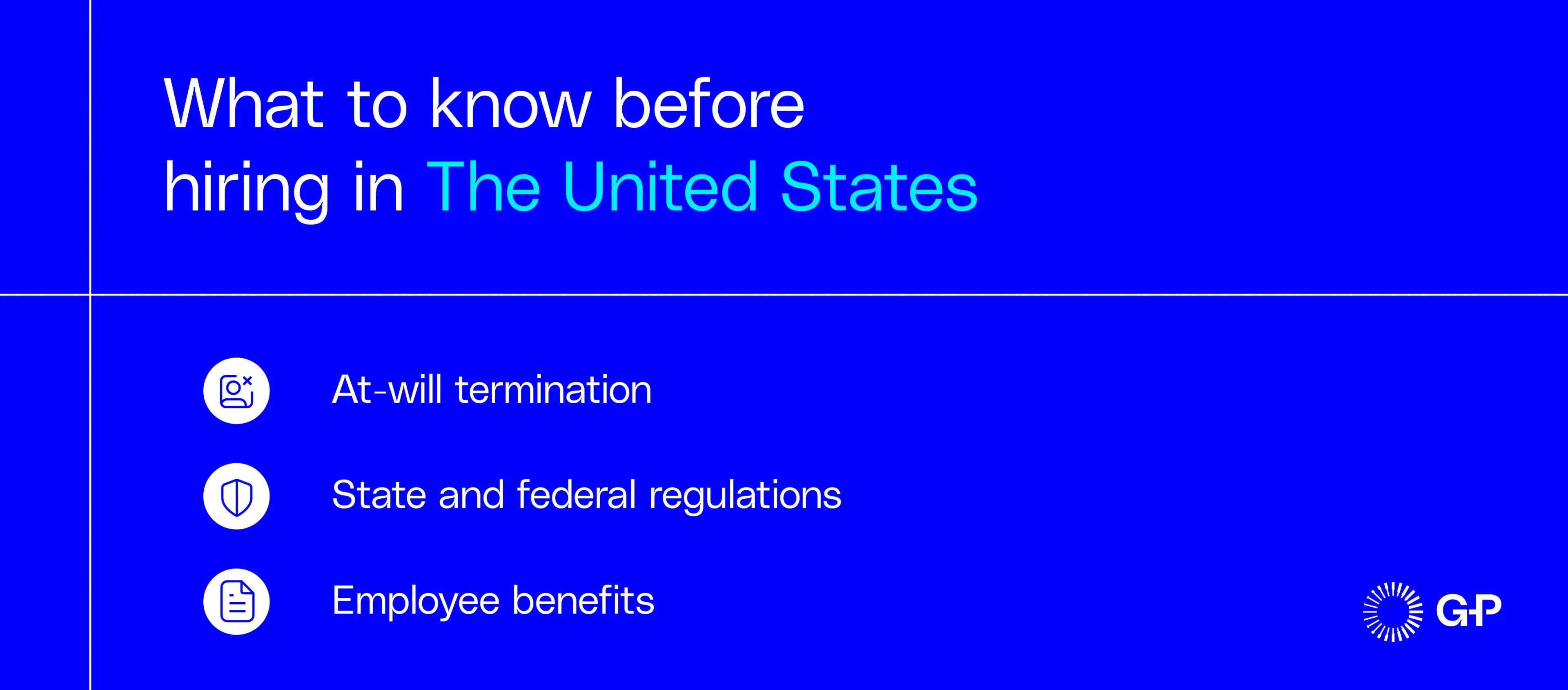
If you’re expanding your business into the U.S. for the first time, there are important legal requirements to be aware of. These norms and laws influence hiring practices in the U.S. and many aspects of the employer-employee relationship, including compensation and benefits.
G-P Gia™, our AI-powered global HR agent, can answer your toughest compliance questions across 50 countries — including the U.S. — and all 50 U.S. states. Reduce your reliance on outside counsel and cut the time and cost of compliance by up to 95% with Gia.
Here are five things to know about hiring in the U.S.
1. At-will employment and termination in the United States
Most U.S. states have at-will employment. Employers can terminate employees at any time, for any legal reason (or no reason), and employees can leave their jobs at any time, for any reason, without legal penalty. Notice and severance pay are not legally required in most cases, though many employers provide them as a courtesy or for higher-level roles.
Employment contracts aren’t standard for most U.S. employees, except for executives or specialized positions. Most workers are hired without a formal contract. Montana is the only state that doesn’t follow the at-will doctrine after a probationary period. Exceptions to at-will employment still apply, such as terminations that violate anti-discrimination laws, public policy, or an existing employment contract.
2. Payroll and taxes in the United States
Employers have to add employees to payroll, withhold federal (and usually state) income taxes, and remit these to tax authorities. Both employers and employees contribute 6.2% of wages to social security.
Employees are subject to federal income tax withholding. This is progressive and ranges from 10–37%. State income tax rates and brackets vary by state. Some states have no income tax, while others have flat or progressive rates. Employers and employees contribute 1.45% to Medicare, with an extra 0.9% employee-only Medicare tax for high earners.
3. Standard working hours in the U.S.
The workweek in the U.S. is 40 hours, spread across eight hours per day, five days per week. Alternative schedules in healthcare and other industries are common. Some companies offer shorter workweeks or part-time roles. For overtime, the U.S. law distinguishes between exempt and nonexempt employees under the Fair Labor Standards Act (FLSA):
-
Exempt employees (usually salaried, in executive, administrative, professional, or certain creative roles) don’t get overtime pay.
-
Nonexempt employees are entitled to overtime pay at 1.5 times their regular hourly wage. An employee making USD 10 per hour would make USD 15 per hour in overtime.
4. Employee benefits in the U.S.
Private employers don’t have to provide paid vacation, paid sick leave, or paid parental leave.
The Affordable Care Act (ACA) requires employers with 50 or more full-time employees to offer affordable, minimum essential health coverage. Smaller employers can access the Small Business Health Options Program (SHOP) and can be eligible for tax credits. Employer-sponsored health insurance is a big part of compensation. Out-of-pocket costs for U.S. employees remain among the highest in the world.
The Family and Medical Leave Act (FMLA) provides up to 12 weeks of unpaid, job-protected leave for certain family and medical reasons, but only for employees at companies with 50 or more employees and who meet eligibility requirements.
The U.S. has 10 federal holidays. Private employers aren’t required by law to provide these days off or pay extra for work on holidays.
5. State and federal regulations in the United States
U.S. employment regulations are a blend of state and federal laws. For instance, federal law imposes a minimum wage, currently USD 7.25 per hour. However, individual states can impose higher minimum wage laws if they choose.
In Montana, the minimum wage is USD 8.75 per hour. In New York, it’s USD 15 per hour. In Wyoming, it’s USD 5.15 per hour.
Federal law requires employees to prove they’re eligible to work in the U.S. No matter what state they plan to work in, global employees have to be prepared to show valid work visas.
Top hiring hubs in the U.S.
Some cities in the U.S. are known for particular industries. Knowing what each city has to offer allows you to focus your hiring efforts in the right place and fill roles faster.
The top talent hubs in the U.S. are:
-
New York City is the largest U.S. city and a global center for finance, technology, healthcare, media, and professional services.
-
Los Angeles is a hub for entertainment, technology, healthcare, and global trade.
-
Chicago is known for its finance, manufacturing, logistics, and healthcare sectors.
-
Houston is a leader in energy, healthcare, aerospace, and manufacturing.
-
Dallas-Fort Worth is a fast-growing region in technology, finance, and logistics.
-
San Francisco Bay Area is the center of the tech industry, including San Francisco, San Jose, and Oakland.
-
Atlanta is a big center for logistics, media, technology, and corporate headquarters.
-
Boston is known for healthcare, education, biotechnology, and finance.
-
Seattle is home to major employers like Amazon, Microsoft, and Boeing.
-
Washington DC Metro Area, includes DC, Northern Virginia, and Maryland, and has strong government, tech, and consulting sectors.
-
Miami is a gateway for global business, tourism, and finance.
-
Austin is a fast-growing tech and innovation center.
Key industries in the U.S.
Understanding the main industries in the U.S. allows you to benchmark salaries and benefits. You can use this insight to make smart choices about where to invest and grow your workforce.
The main industries in the U.S. include:
-
Finance, insurance, and real estate: This industry is the largest GDP contributor in the U.S. This includes commercial banking (USD 1.42T), health insurance (USD 1.54T), property/casualty insurance, and commercial real estate market (USD 1.48T).
-
Professional, scientific, and technical services: This industry includes legal, accounting, consulting, engineering, and architectural services.
-
Healthcare and social assistance: The U.S. healthcare industry is one of the largest single industries by revenue globally. Hospitals and medical insurance generate trillions of dollars.
-
IT: While only a portion of the overall service sector, the information sector (which includes software, data processing, and IT services) is important to every other industry.
-
Energy and mining: The U.S. is the world's largest producer of petroleum and natural gas.
Cost of hiring an employee in the United States
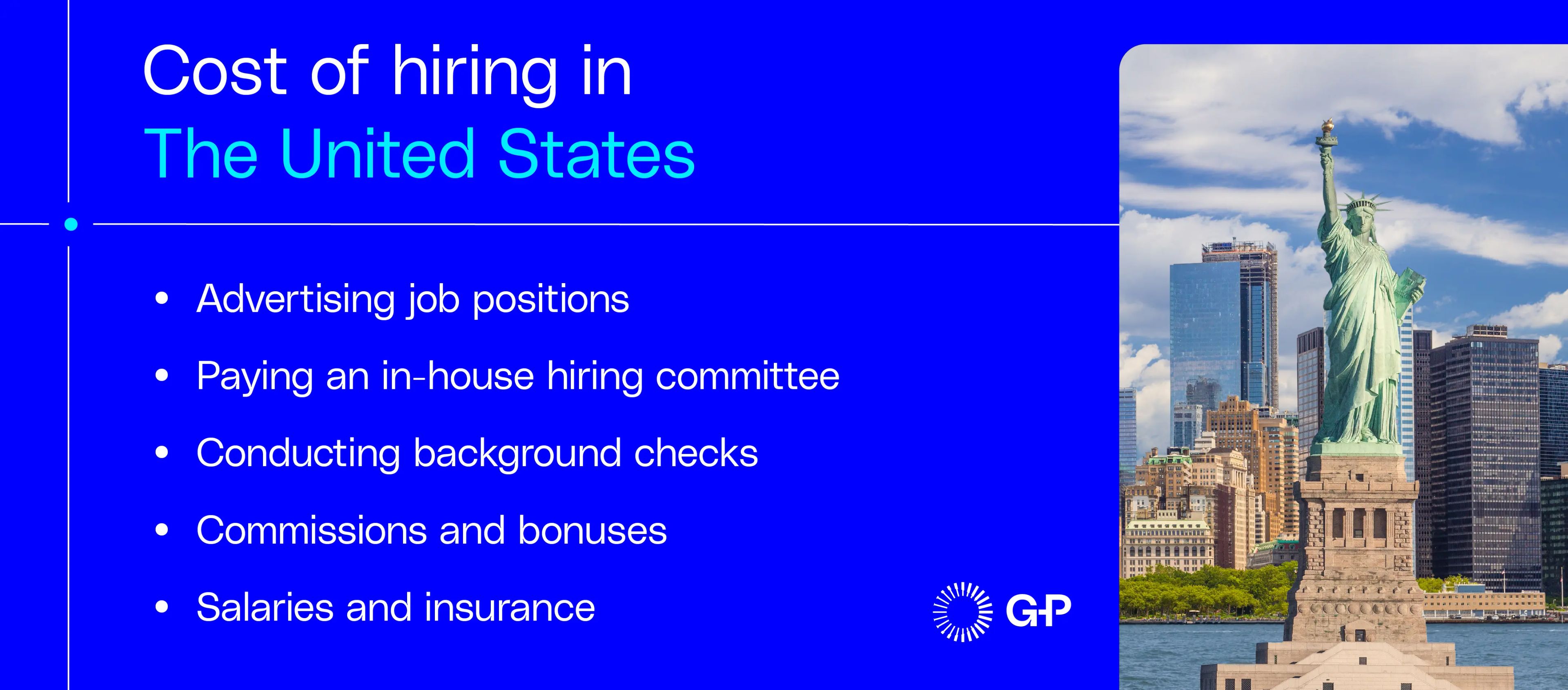
Whether you’re hiring one employee or an entire team in the U.S., expenses are inevitable. Budget for the following:
-
Entity setup (unless you partner with an employer of record)
-
Job advertisements
-
Labor costs for applicant review
-
Payroll
-
Taxes
-
Salaries
-
Benefits
-
Bonuses
-
Allowances
-
Insurance
-
Travel
According to G-P Verified Sources from Gia, the employer burden rate in the U.S., which includes costs triggered on top of salaries, is approximately 7.65–10%.
What does a company need to hire employees in the U.S.?
Make sure you cover these essentials before expanding your team in the U.S.:
-
Choose a legal structure.
-
File formation documents.
-
Get an employer identification number (EIN).
-
Register with state tax authorities.
-
Register for local taxes (some cities/counties require extra registrations).
-
Set up a system to calculate, withhold, and remit federal and state income taxes, social security, and Medicare.
-
Register for unemployment insurance.
-
Register for workers’ compensation insurance.
-
Draft compliant offer letters and employment agreements.
-
Develop employee handbooks and policies.
-
Complete Form I-9 for each new hire and retain documentation.
-
Report new hires to the state. Most states need reporting within 20 days of hire.
Setting up a U.S. subsidiary can take weeks or months. Use G-P EOR to hire full-time employees in the U.S. without setting up your own entity. Build your team in the U.S. at a lower cost and with peace of mind that you’re doing so compliantly.
Steps to hiring in the U.S.
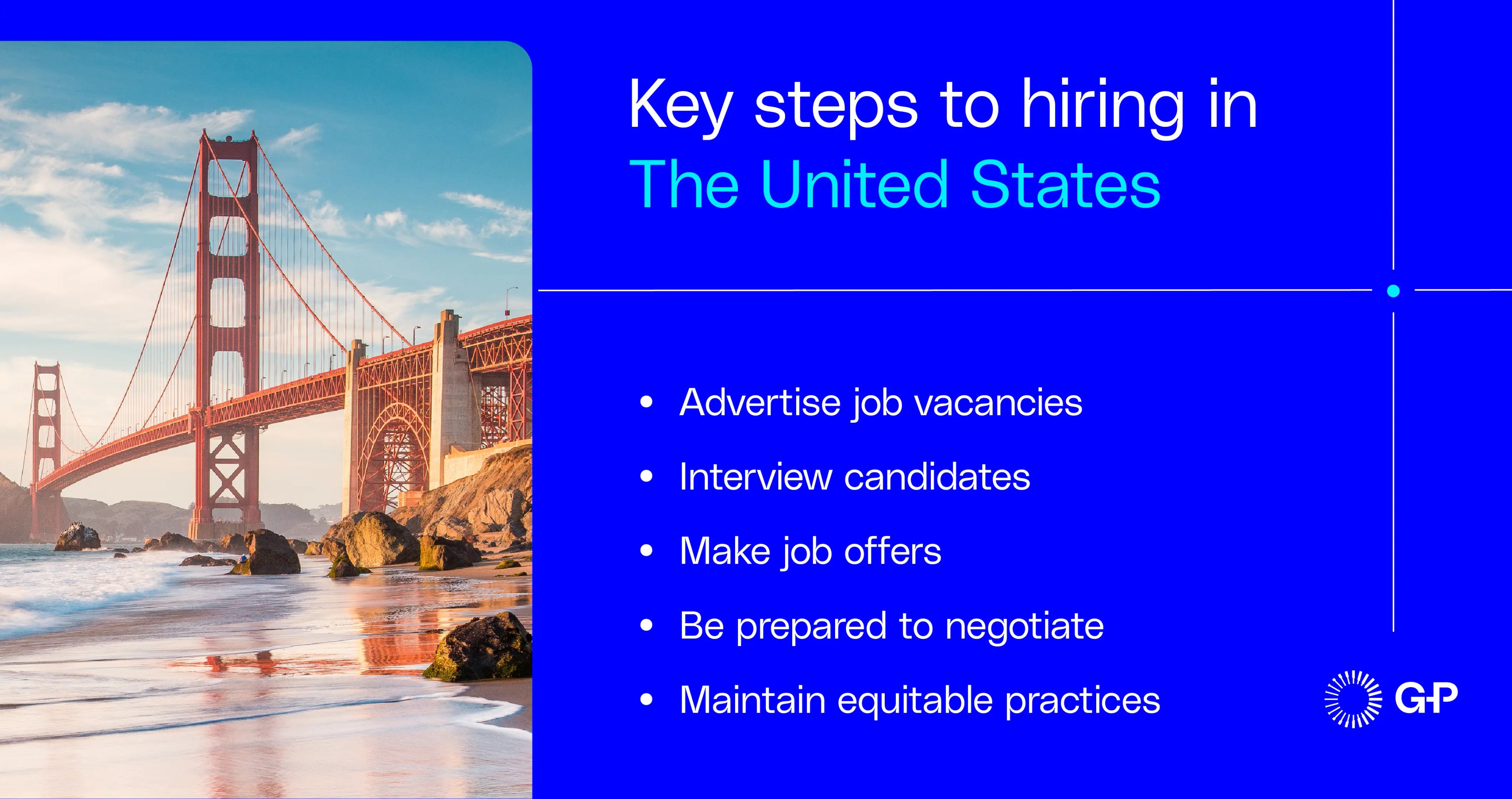
Steps to hiring in the U.S.
The hiring process in the U.S. is similar to the one you’re likely familiar with in your own country. The hiring process follows five basic steps: advertising the job, evaluating applications, interviewing candidates, sending job offers, and onboarding new employees.
1. Advertise job vacancies in the U.S.
Create a detailed job description and define the role based on responsibilities and qualifications. Write a clear job description outlining duties, qualifications, and skills needed. Determine compensation and benefits. It’s best practice to include an Equal Opportunity Employer (EOE) statement to signal your commitment to fair hiring.
State and local laws may require salary range disclosure in job postings (e.g., California, Colorado, New York, New Jersey as of June 2025). Indeed and LinkedIn are popular job sites in the U.S.
2. Evaluating applications in the United States
Collect applications and review resumes. Screen candidates based on their qualifications, experience, and fit for the role. Employers with 15+ employees must provide reasonable accommodations to applicants with disabilities (e.g., accessible application formats, interpreters for interviews, etc.).
3. Interviewing candidates in the United States
Interview candidates who made it onto your shortlist. You can do these interviews in-person or virtually. Use structured, nondiscriminatory interview questions. Gia can help you create questions that follow anti-discrimination laws in the U.S., so you can find the best fit for the role while complying with local regulations.
4. Making job offers in the United States
Contact your chosen candidate to offer them a position with your company. Have the employee complete Form I-9 (work eligibility verification) and Form W-4 (tax withholding). Provide any state-required forms and notices. Report the new hire to the state’s new hire registry (needed in all states, usually within 20 days).
5. Onboarding new employees in the United States
Now you can onboard new employees. Set up payroll and benefits. Provide orientation, your employee handbook, and required labor law posters.
If you’re working with an EOR like G-P™, you won’t have to worry about the administrative burden of onboarding. We’ll streamline the process, so you can focus on training your new hire and integrating them into your company culture.
Hiring contractors in the U.S.
Working with independent contractors in the U.S. can be a cost-effective way to test the market and build a presence, without the commitment of full-time employees. Contractors based in the U.S. understand local consumer behavior, rules, and business practices. They’ll be ready to start working quickly with their own equipment and established work processes.
Hiring contractors allows you to easily adjust your workforce based on your business needs, without the complexities and costs of employment.
Before you enter an agreement with an independent contractor in the U.S., consider the following:
1. Employees vs. independent contractors in the U.S.
It’s important to understand the difference between employees and independent contractors. In the U.S., employers hire employees to do work and, in return, pay them a regular salary and benefits. Independent contractors provide services. Unlike employees, contractors set their schedules, use their own equipment, and work on specific projects rather than having an ongoing role.
2. Penalties for misclassification in the United States
Classifying someone as a contractor when they’re not can lead to severe penalties. If misclassification occurs, you’ll have to:
-
Back pay wages, overtime, and benefits owed to the misclassified worker.
-
Pay unpaid payroll taxes (social security, Medicare, unemployment insurance), plus interest and penalties.
-
Face extra state-level penalties.
3. How to pay contractors in the U.S.
G-P Contractor™ takes away the messy, time-consuming process of hiring and paying international contractors. You can create and issue contracts and pay contractors with just a few clicks, all while ensuring a compliant process.
Hire employees and contractors in the U.S. with G-P
Our SaaS and AI-powered products – EOR, Contractor, and Gia – support companies as they build and manage global teams.
G-P is the recognized leader in global employment with more than a decade of experience, the largest team of HR, legal, and compliance experts, and a global proprietary knowledge base.
Make your expansion to the U.S. easier with G-P. Contact us or book a demo today.


